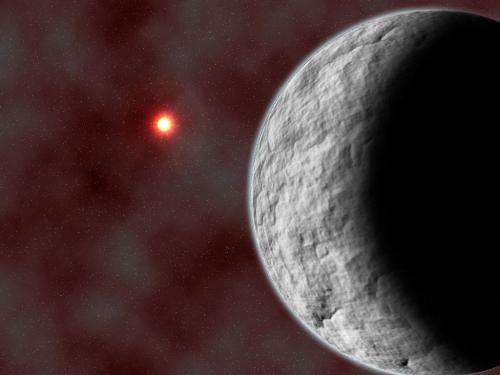Rocky, low-mass planet discovered by microlensing

In planet hunting today, there seems to be one burning question that nearly every new article published touches on: Where did these planets come from?
As astronomers discovered the first extrasolar planets, it quickly became obvious that the formation theories that we’d built on our own solar system were only part of the story. They didn’t predict the vast number of hot Jupiters astronomers found nearly everywhere. Astronomers went back to the drawing board to put more details into the theory, breaking formation down into quick, single collapses and more gradual accretion of gas disks, and worrying about the effects of migration. It’s likely all these effects take place to some extent, but ferreting out just how much is now the big challenge for astronomers. Hampering their efforts is the biased sample from the gravitational-wobble technique which preferentially discovered high mass, tightly orbiting planets. The addition of Kepler to planet hunter’s arsenal has removed some of this bias, readily finding planets to far lower masses, but still prefers planets in short orbits where they are more likely to transit. However, the addition of another technique, gravitational microlensing, promises to find planets down to 10 Earth masses, much further out from their parent stars. Using this technique, a team of astronomers has just announced the detection of a rocky planet just in this range.
According to the Extrasolar Planet Encyclopaedia, astronomers have discovered 13 planets using gravitational microlensing. The newly announced one, MOA-2009-BLG-266Lb, is estimated to be just over 10 times the mass of Earth and orbits at a distance of 3.2 AUs around a parent star with roughly half the mass of the Sun. The new finding is important because it is one of the first planets in this mass range that lies beyond the “snow line”, the distance during formation of a planetary system beyond which ice can form from water, ammonia, and methane. This presence of icy grains is expected to assist in the formation of planets since it creates additional, solid material to form the planetary core. Just beyond the snow line, astronomers would expect that planets would form the most quickly since, as you move further, beyond this line, the density drops. Models have predicted that planets forming here should quickly reach a mass of 10 Earth masses by accumulating most of the solid material in the vicinity. The forming planet then, can slowly accrete gaseous envelopes. If it accumulates this material quickly enough, the gaseous atmosphere may become too massive and collapse, beginning a rapid gas accretion phase forming a gas giant.
The timing of these three phases, as well as their distance dependency, makes testable predictions that can be contrasted with the observations as astronomers discover more planets in this vicinity. In particular, it has suggested that we should see few gas giants around low mass stars because the gas disk is expected to dissipate before the atmosphere collapse leading to the rapid accretion phase. This expectation has been generally supported by the findings of the 500+ confirmed extrasolar planets, as well as the 1,200+ candidates from Kepler, lending credence to this core collapse + slow accretion model. Additionally, Kepler has also reported a large population of relatively low mass planets, interior to the snow line. This too supports the hypothesis since the greater difficulty in forming cores without the presence of ice would hamper the formation of large planets. However, other predictions, such as not expecting massive planets in tight orbits, is still largely contradictory to the hypothesis and greater testing with additional discoveries will be needed.
Assisting with this, several new observing programs will be coming on line in the near future. The Optical Gravitational Lensing Experiment IV (OGLE-IV) has just entered operation and a new program at Wise Observatory in Tel Aviv will begin operation following up on microlensing events next year. Also expected in the near future is the Korean Microlensing Network (KMT-Net) which will operate telescopes in South Africa, Chile, and Australia using 1.6 meter telescopes covering 4 square degrees of the galactic bulge.
Provided by Universe Today


















